Serving 606 students in grades Prekindergarten-5, G W Bulluck Elementary School ranks in the bottom 50% of all schools in North Carolina for overall test scores (math proficiency is bottom 50%, and reading proficiency is bottom 50%).
The percentage of students achieving proficiency in math is 23% (which is lower than the North Carolina state average of 51%). The percentage of students achieving proficiency in reading/language arts is 25% (which is lower than the North Carolina state average of 50%).
The student:teacher ratio of 15:1 is equal to the North Carolina state level of 15:1.
Minority enrollment is 75% of the student body (majority Black), which is higher than the North Carolina state average of 57% (majority Black).
Quick Stats (2025)
- Grades: Prekindergarten-5
- Enrollment: 606 students
- Student:Teacher Ratio: 15:1
- Minority Enrollment: 75%
- Overall Testing Rank: Bottom 50% in NC
- Math Proficiency: 23% (Btm 50%)
- Reading Proficiency: 25% (Btm 50%)
- Science Proficiency: 25-29% (Btm 50%)
- Source: National Center for Education Statistics (NCES), NC Dept. of Education
Top Rankings
G W Bulluck Elementary School ranks among the top 20% of public schools in North Carolina for:
Category
Attribute
Percent Eligible For Free Lunch
School Overview
G W Bulluck Elementary School's student population of 606 students has declined by 17% over five school years.
The teacher population of 41 teachers has declined by 8% over five school years.
Grades Offered
Grades Prekindergarten-5
Total Students
606 students
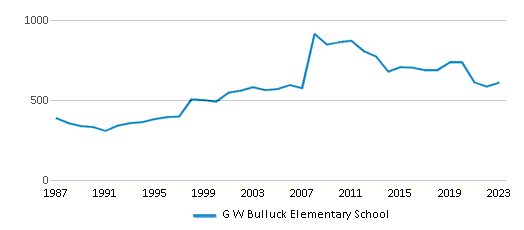
Gender %
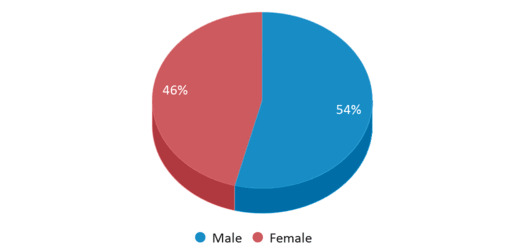
Total Classroom Teachers
41 teachers
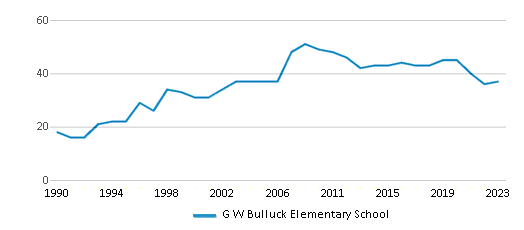
Students by Grade
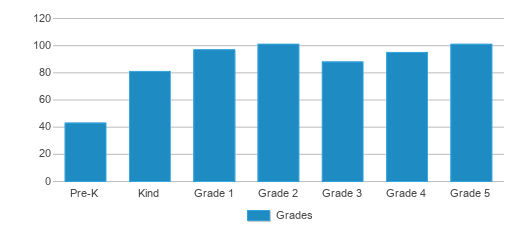
School Rankings
G W Bulluck Elementary School ranks within the bottom 50% of all 2,617 schools in North Carolina (based off of combined math and reading proficiency testing data).
The diversity score of G W Bulluck Elementary School is 0.58, which is less than the diversity score at state average of 0.71. The school's diversity has stayed relatively flat over five school years.
Overall Testing Rank
#2433 out of 2617 schools
(Bottom 50%)
(Bottom 50%)
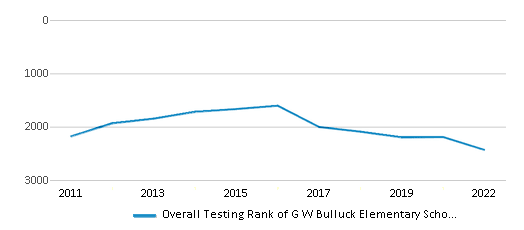
Math Test Scores (% Proficient)
23%
51%
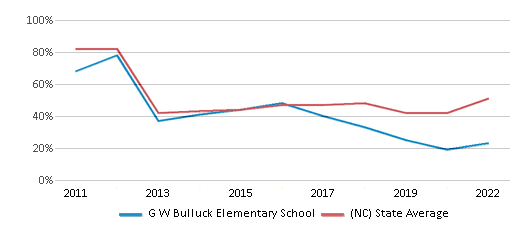
Reading/Language Arts Test Scores (% Proficient)
25%
50%
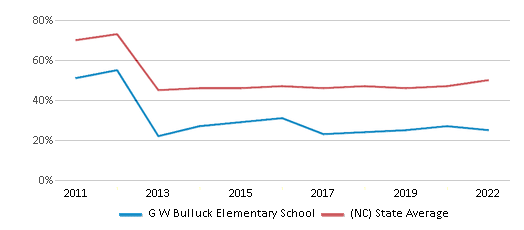
Science Test Scores (% Proficient)
25-29%
63%

Student : Teacher Ratio
15:1
15:1
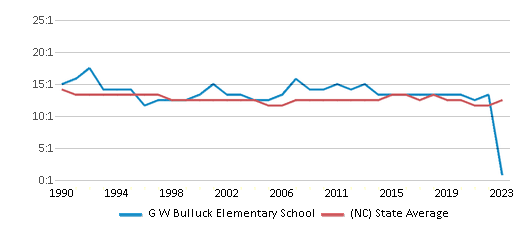
American Indian
n/a
1%
Asian
n/a
4%
Hispanic
8%
21%
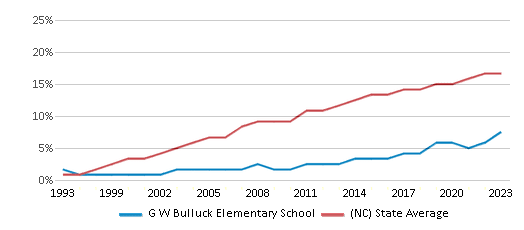
Black
59%
25%
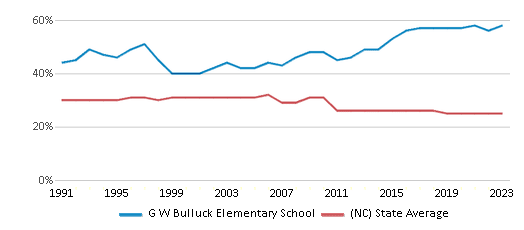
White
25%
43%
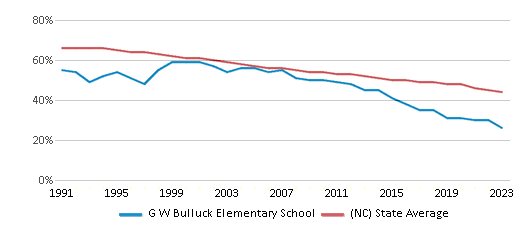
Hawaiian
n/a
n/a
Two or more races
8%
6%
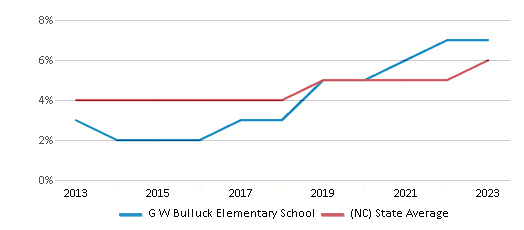
All Ethnic Groups
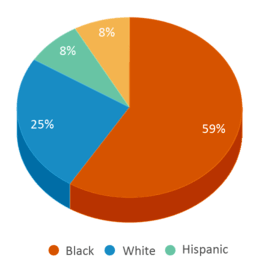
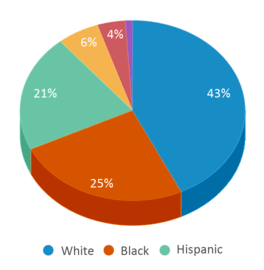
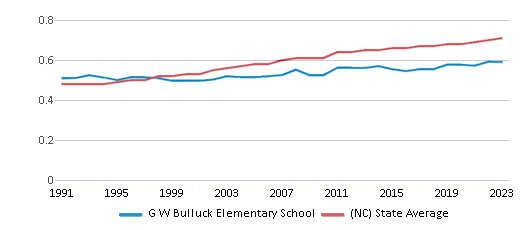
Participates in the National School Lunch Program (NSLP)
Yes
Eligible for Free Lunch
100%
68%
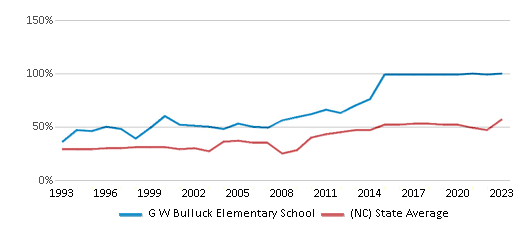
Eligible for Reduced Lunch (13-14)
9%
7%
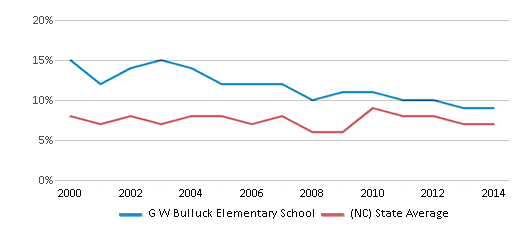
School Statewide Testing
School District Name
Source: National Center for Education Statistics (NCES), NC Dept. of Education
Profile last updated: 02/09/2025
Frequently Asked Questions
What is G W Bulluck Elementary School's ranking?
G W Bulluck Elementary School is ranked #2433 out of 2,617 schools, which ranks it among the bottom 50% of public schools in North Carolina.
What percent of students have achieved state testing proficiency in math and reading?
23% of students have achieved math proficiency (compared to the 51% NC state average), while 25% of students have achieved reading proficiency (compared to the 50% NC state average).
How many students attend G W Bulluck Elementary School?
606 students attend G W Bulluck Elementary School.
What is the racial composition of the student body?
59% of G W Bulluck Elementary School students are Black, 25% of students are White, 8% of students are Hispanic, and 8% of students are Two or more races.
What is the student:teacher ratio of G W Bulluck Elementary School?
G W Bulluck Elementary School has a student ration of 15:1, which is equal to the North Carolina state average of 15:1.
What grades does G W Bulluck Elementary School offer ?
G W Bulluck Elementary School offers enrollment in grades Prekindergarten-5
What school district is G W Bulluck Elementary School part of?
G W Bulluck Elementary School is part of Edgecombe County School District.
School Reviews
1 9/20/2018
Bullying is taken very lightly at this school. As a former student of G.W Bulluck School, the staff today in the central office are not doing there job as they should. My sister who currently attends this school has been bullied horribly for the pass few years on the bus that she no longer will be riding their school buses. Bullying on the buses needs to be constantly watched.
5 5/17/2016
The school is truly amazing. It does not have much money or technology, but it makes up for it in wonderful teachers and staff. The school is full of people who love children and education. The school gets better every year and I haven't heard a bad word spoken about anyone or complaining. I don't know what the parent from 2010 is talking about. I love the school!
2 5/31/2010
Teachers are very immature. Children don't get enough exercise. They don't have a gym and they don't use their very small auditorium for inside activities for the kids. Teachers complain more than teaching so the children who want to learn suffer for the lack of education provided!
Review G W Bulluck Elementary School. Reviews should be a few sentences in length. Please include any comments on:
- Quality of academic programs, teachers, and facilities
- Availability of music, art, sports and other extracurricular activities
Recent Articles

What Is A Charter School?
Explore the world of charter schools in this comprehensive guide. Learn about their history, how they operate, and the pros and cons of this educational innovation. Discover key facts about charter schools, including admission policies, demographics, and funding, as well as what to look for when considering a charter school for your child.

10 Reasons Why High School Sports Benefit Students
Discover the 10 compelling reasons why high school sports are beneficial for students. This comprehensive article explores how athletics enhance academic performance, foster personal growth, and develop crucial life skills. From improved fitness and time management to leadership development and community representation, learn why participating in high school sports can be a game-changer for students' overall success and well-being.

February 05, 2025
Understanding the U.S. Department of Education: Structure, Impact, and EvolutionWe explore how the Department of Education shapes American education, from its cabinet-level leadership to its impact on millions of students, written for general audiences seeking clarity on this vital institution.





